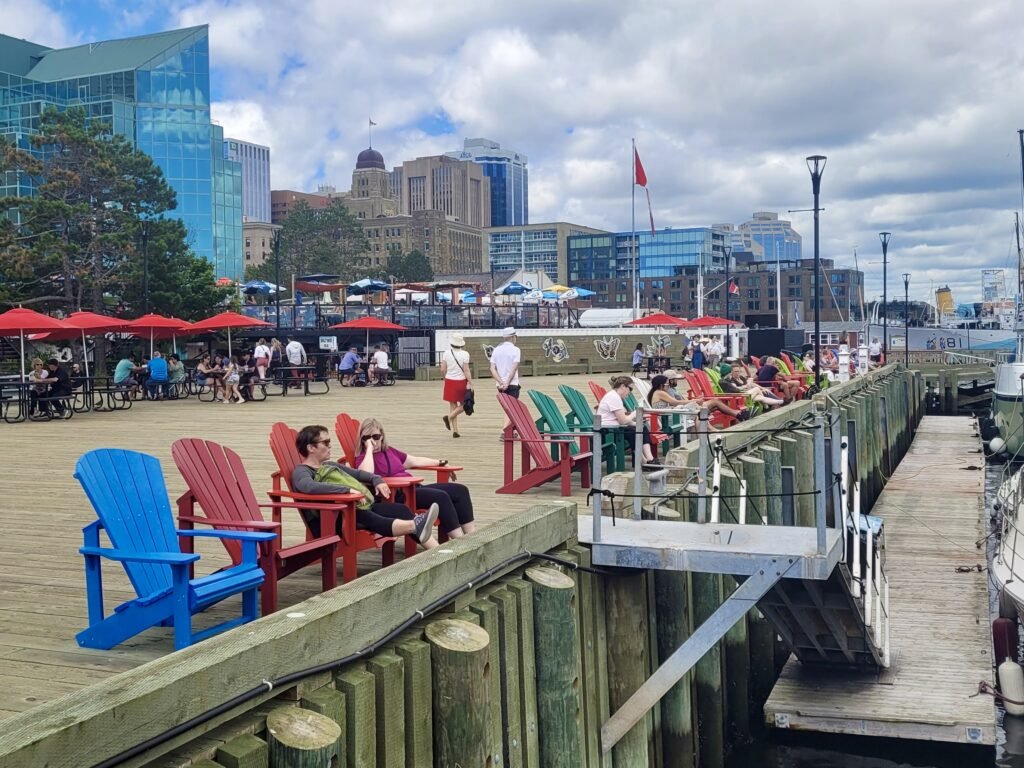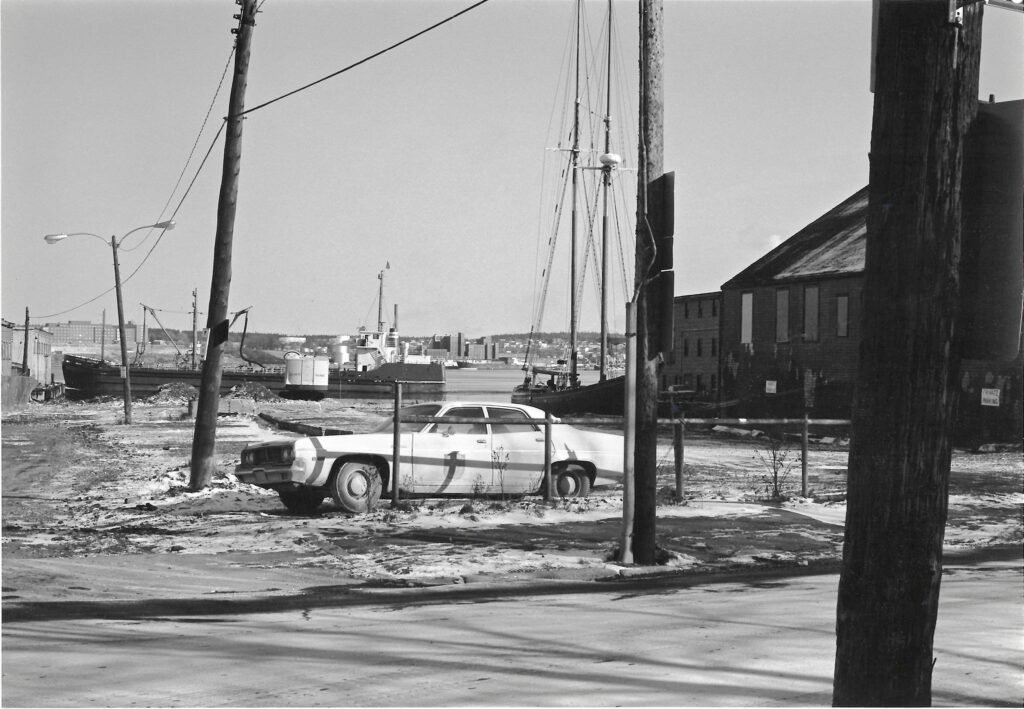How Halifax Built the Most Vibrant Waterfront in Canada: Decades of Small Changes
This article was originally published in Happy Cities. It is shared here with permission.
Salt Yard at night, a public space of over 30,000 square feet along the Halifax Waterfront. (Source: Build Nova Scotia.)
What would happen if government made improvements to a public space one year, and then did it again the next year? And then the next, and the next.
Let me introduce you to the Halifax Waterfront. The place has a rare advantage: There’s a government agency whose mandate is to improve this place each year. That means there is a group of bureaucrats whose job is to keep asking: What is the next thing we can do here? What can make this just a little better?
They have been doing this work for decades now, and the results are astounding. It demonstrates how powerful placemaking can be, if government treats it not as a one-off gesture, but as a central policy goal.
The Cumulative Impact of Many Small Changes
When you walk along the waterfront, you pass through multiple places that feel totally distinct. Some parts offer a quiet place to relax or walk a dog (when you’re not playing volleyball).
Salter Street Landing. (Source: Tristan Cleveland.)
Or watch the water.
Adirondack chairs on the waterfront. (Source: Tristan Cleveland.)
Just a few feet over you can grab lunch at a set of outdoor kiosks—on a spot that was a parking lot until a few years ago. (The ground is still the same pavement, but you wouldn’t notice).
Kiosks on the Waterfront. (Source: Build Nova Scotia.)
A few feet later, you can grab a drink and take in the energy of a big crowd. At night, you can see live music here.
(Source: Tristan Cleveland.)
And after that, it’s time to play. This piece of public art, The Wave, has become one of the busiest playgrounds in the city, with a constant flow of children scrambling up its slope.
The Wave, Halifax. (Source: Riaz Oozeer.)
Then there’s the actual playground, a few feet over.
Playground on Halifax Waterfront. (Source: Tristan Cleveland.)
Then you walk around the corner, and you’re somewhere monumental.
Queen’s Marque. (Source: Harrison Jardine / Fathom Studio.)
A minute later, you’re somewhere casual again—the ferry terminal, with its much more affordable food.
The Halifax ferry terminal, with new public seating. (Source: Tristan Cleveland.)
Along the way, the place is throbbing with life: people buying lunch, playing, shopping, sitting, watching, flirting, busking, even dancing.
Bringing Life to the Waterfront
It was not always like this. Just a few decades ago, the waterfront remained a gritty workplace. By the 1970s, the waterfront had largely lost its role in shipping and fishing and was falling into decline. In 1976, Nova Scotia created The Waterfront Development Corporation to protect public access to the waterfront. Over time, this mandate morphed into something different: to make the waterfront as welcoming as possible.
Halifax Waterfront, 1975. Compare this to the view today. (Source: Gary Wilson.)
Logically, the waterfront should not have succeeded. Although it does have one asset—the water—its location is otherwise terrible. It is at the tip of a peninsula, meaning few people can walk through the waterfront to get anywhere useful. And it’s hard to get there. To the north, the way is blocked by a highway interchange, a 1960s mega mall, and an eighteenth century fortress called Citadel Hill. The waterfront is next to the downtown, but it is separated by a big, daunting hill.
Many barriers make it difficult to reach the Halifax waterfront. (Image from Google Earth, with labels added by Tristan Cleveland.)
But the waterfront attracts well over 100,000 people per year, according to Build Nova Scotia staff. Even on a weekday it is full of people from one end to the other. Why do all these people go out of their way to get there?
The Big Power of Small Investments
Jenna Rideout, from Build Nova Scotia (the organization that now oversees the waterfront) tells me a story that helps outline the organization’s approach. Last year, her team noticed that people were not spending time in a place called the Salter Street Landing. The area had a parking lot on one side, and empty grass on the other. It did have a volleyball court, but little more. Plenty of people walked through the area, but few would linger.
So this year, the team made a few simple changes. They bought some beach chairs and put them on the sand and the grass (the red and yellow chairs in the photo below). They painted an obstacle course on the pavement, with instructions for kids to hop, spin, and jump. They added three new kiosks for tiny businesses, and positioned them between the sidewalk and the parking lot. These kiosks had the double benefit of giving people more to look at, and blocking the view of the parking lot. They also added a shipping container and turned it into a retail space, which entrepreneurs can rent out for a week at a time.
Salter Street Landing. (Source: Tristan Cleveland.)
Remarkably, the pedestrian counts for Salter Street now even beat the new public space in the Queen’s Marque, a $200 million development project. Queen’s Marque is also successful, as is obvious in the photo below. But the area simply doesn’t have as many reasons for people to stop and spend time there compared to that little patch of sand and grass at Salter Street. (Rideout estimates that the improvements to Salter Street Landing cost around $12,000.)
Queen’s Marque. (Source: Harrison Jardine/Fathom Studio.)
If the Waterfront is now full of life, it is because Rideout’s team has been making these kinds of small investments in public space year after year. Every corner offers a half-dozen things to do—thanks to the cumulative impact of decades of small investments. For Queen’s Marque to compete with Salter, it will need more of the cheap stuff: chairs, games, color.
The Alternative
Compare the Salter approach to the Halifax Commons. It’s a green space in the center of the city, one of the easiest for most people to access. But on lovely summer days, large parts of it are often empty.
The Halifax Commons. (Source: Tristan Cleveland.)
Halifax has invested in major assets in the Commons, including a skate park, an outdoor skating rink, and a swimming pool, which are popular. The municipality also has a master plan for the Commons and will soon make big investments to make the greenspace more usable.
Halifax does not, however, have a team dedicated to making small investments year after year to continuously improve the Commons. It is not currently anyone’s job to ask, each spring, whether any areas of the park are underused, and what can be done to bring life to them. If the upcoming big investments have gaps, it may be many years before the city is ready to make another big investment to fix them.
The Commons represents how most cities manage their parks. Cities tend to make major investments in headline projects, but struggle to spend on small, cheap projects. Similar to Queen’s Marque, Halifax has done a good job with the big gestures in places like the Commons, but it doesn’t have a budget to add new umbrellas, paint, kiosks, and games each year to bring life and color into every corner of the park.
The Right Kind of Budget
Rideout’s team has been successful at placemaking, in part, because her organization is set up for it. When the team invested in the Salter Street landing, they did not have to go through a long planning process or get approvals from multiple departments. Rather, they used their “Tenant Marketing Budget”—a small pot of money that businesses on the waterfront pay into. The Waterfront also has a master plan that sets broad goals, and empowers staff to experiment with interventions that could support those goals. If any of these experiments fail to attract street life, they have the ability to try again. The projects don’t cost much, so there’s not much to lose.
Rideout tells me her team calls this budget the “Sparkle Budget,” which I thought was corny at first, but then it made sense to me. The purpose of this budget is to add that extra touch to public spaces that make them feel like they sparkle.
In recent years, the team has added orange hammocks, murals, an outdoor xylophone and drums, two new music stages, a temporary floating walkway, a painted obstacle course, a photo cut-out board (of a famous local painting), many new kiosks, artsy public seating (built by architecture students), shade sails, colorful Adirondack chairs, bistro chairs, tables, garden boxes, more chairs, more benches, and more chairs.
The orange hammocks on the waterfront. (Source: Tristan Cleveland.)
Consider this patch of grass, pictured. Before they added the chairs, the grass was an empty void, like a miniature version of the Halifax Commons. When they started adding chairs and tables, people started sitting down, and before they could even finish placing them the chairs were half full (as you can see in this funny timelapse video from Build Nova Scotia).
Being an Open Door
Not all of this vibrancy is thanks to small projects. Developers have also built big new developments on the waterfront, such as Bishops Landing, pictured. But as we have argued elsewhere, that’s the point: Successful placemaking creates a desirable place where developers want to invest, and the new homes and businesses help make public spaces more successful. This is the basic formula for how to make vibrant urban centres, creating a self-reinforcing process that leads to greater vibrancy and social life.
Bishop’s landing. (Source: Tristan Cleveland.)
And many of the best ideas for improving the waterfront did not come from government. A few years ago, a local entrepreneur proposed opening an outdoor bar on the waterfront. Now there are three outdoor bars, and it can be hard to get a seat. Last year, someone proposed creating a sea-doo rental business. Now it is one of the most popular attractions on the waterfront.
Bar Sabbia, the newest outdoor bar on the waterfront. (Source: Bar Sabbia on Instagram.)
It is usually difficult to wrangle this kind of “yes” out of government, because few government agencies have the explicit mandate to make a place as vibrant as possible. If we created more agencies with this kind of explicit mandate, we would get a lot more yeses.
Too many public spaces in cities today feel empty, and too few feel like the Halifax Waterfront. It need not be this way. Any city can create a team whose job is to keep improving public spaces every single year. The improvements need not be expensive, and they generate disproportionate value in new developments and businesses.
It is this consistency that unlocks the true potential of placemaking: the cumulative impact of many small improvements over decades, until going for a short walk makes you feel like you’ve visited a dozen wonderful places.
Tristan Cleveland is a community designer and urban columnist. He leads Happy Cities’ Healthy Communities research and speaks about their work around the world. Cleveland completed his PhD at Dalhousie University’s Healthy Populations Institute, where his research focused on finding solutions to operationalize healthy communities. You can connect with Tristan on Twitter at @LUrbaniste.























